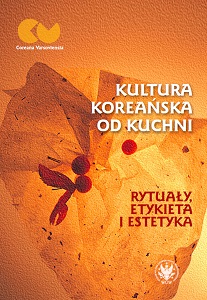Zapiski damy Chang Kye-hyang jako źródło poznawcze z dziedziny antropologii kulinarnej siedemnastowiecznej Korei
Lady Chang Kye-hyang’s Cookbook as a Cognitive Resource in Culinary Anthropology of 17th Century Korea
Author(s): Kamila Kozioł
Subject(s): Cultural history, Theoretical Linguistics, Applied Linguistics, Philology
Published by: Wydawnictwa Uniwersytetu Warszawskiego
Keywords: Chang Kye-hyang; Ŭmsik timi-pang; Korean recipes; Korean cooking; XVII-century food
Summary/Abstract: The study examines the 17th century mansucript Ŭmsik timi-pang (Recipes for Tasty Food). This collection, written by an elderly noble woman, gathers 146 recipes describing the preparation, processing and storage of ingredients and dishes. Arranged into three chapters entitled respectively – flour dishes and noodles, fish and meat, and alcohol and vinegar – it is the author’s collection of her experiences to pass it on to daughters, and to subsequent generations of daughters-in-law who, when entering husband’s abode, were expected to adhere to its traditions and way of living. The text of Ŭmsik timi-pang is a unique book with a linguistic perspective. Written in the vernacular script, it provides researchers with case studies for grammar and everyday language of seventeenth-century Korea. The author of this article, however, investigated everyday life and culinary culture of Korea of this period. The second half of the seventeenth century marks the ending of the voluntary alienation period of the kingdom of Chŏson. At the time it was still closed off to news and influences from the West, adhering to established practices instead. The cuisine of this period is a reflection of this, and Ŭmsik timi-pang encapsulates the image of traditional eating habits and food preparation that was often abandoned in later centuries.
Book: Kultura koreańska od kuchni. Rytuały, etykieta i estetyka
- Page Range: 37-75
- Page Count: 39
- Publication Year: 2021
- Language: Polish
- Content File-PDF

